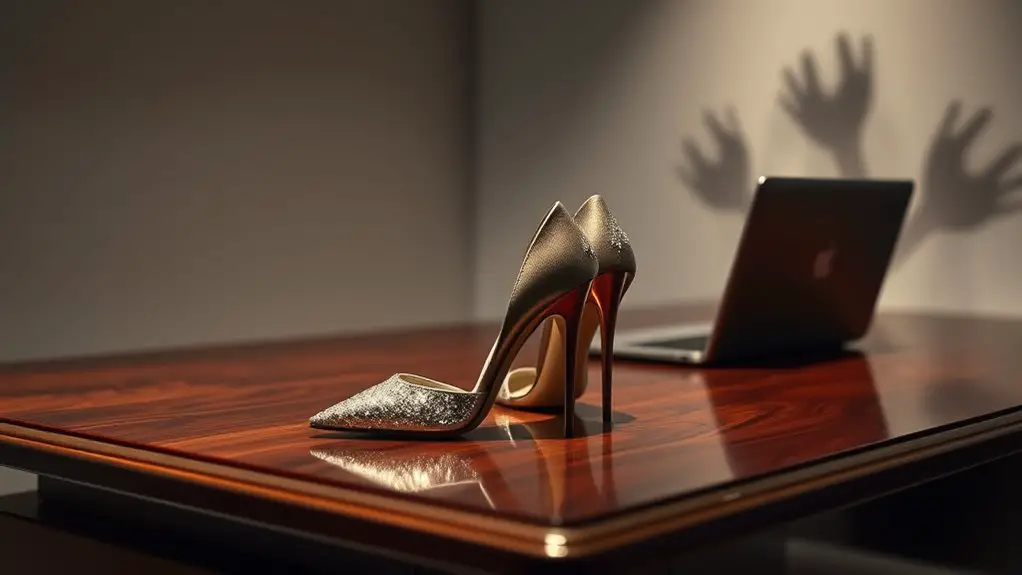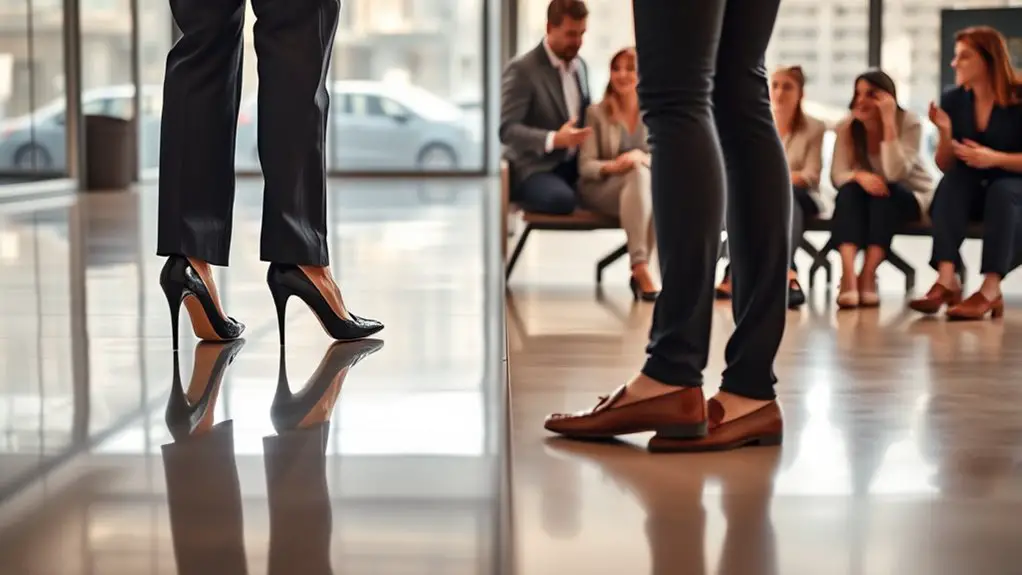High heels in the workplace stir a multifaceted controversy. While they exude power and professionalism, they also carry significant health risks like chronic pain and injury. Many women feel pressured to conform to outdated gender stereotypes that deem heels necessary for success. Yet, there’s a growing push for comfortable footwear that promotes well-being and challenges traditional dress codes. Curious about how this ongoing debate shapes your work environment? You might find the answers enlightening.
The Historical Significance of High Heels in Professional Settings

Although many associate high heels with fashion and femininity, their historical significance in professional settings is far more complex. Imagine this: high heels once signified power and authority, originally worn by aristocrats to elevate their status. As fashion evolved, these shoes shifted into symbols of ambition and professionalism, particularly for women carving their paths in male-dominated workplaces.
In this historical context, wearing heels wasn’t just about aesthetics; it was a statement of resilience and determination. You’ve likely noticed how high heels can transform an outfit, but they also evoke a sense of confidence, suggesting that you belong in the boardroom.
However, this evolution has not been without its controversies. While they’ve become a staple in many professional wardrobes, the underlying implications of wearing them remain a topic of debate. It’s essential to recognize that high heels carry both a legacy of empowerment and a burden of expectation.
Health Risks Associated With Wearing High Heels
You might love the confidence that high heels bring, but have you considered the trade-offs? From foot pain and discomfort to posture issues and long-term joint damage, those stylish shoes could be more harmful than you think. It’s time to weigh the allure against the potential costs to your health.
Foot Pain and Discomfort
High heels, often seen as symbols of elegance and power, can come at a steep price when it comes to foot health. The chic look might catch eyes, but your feet pay the price. Each step can ignite chronic pain, leaving you wondering if the fashion statement is worth the discomfort. You might find yourself battling blisters, calluses, and aching arches, all for a few extra inches. Isn’t it time to reconsider? Alternative footwear doesn’t have to sacrifice style for comfort. Picture chic flats or stylish low heels that keep your feet happy while still making a statement. Your health and comfort deserve just as much attention as your outfit. Why not choose both?
Posture and Balance Issues
Wearing high heels can lead to more than just foot pain; they can greatly impact your posture and balance. When you slip on those stylish shoes, your body shifts into a precarious alignment. Your spine, in an effort to compensate, adjusts in ways that can lead to discomfort and instability. You might feel confident striding into the office, but every step compromises your balance stability, making you more prone to slips and falls. It’s a delicate dance between looking chic and maintaining proper posture alignment. While high heels may elevate your outfit, they can also elevate your risk of injury. So, before you reach for those heels, consider whether the allure is worth the potential health trade-off.
Long-term Joint Damage
While stepping into a pair of high heels might feel empowering, the long-term consequences on your joints can be anything but glamorous. Those towering heels may elevate your style, but they also shift your weight and strain your joints, leading to chronic joint pain over time. The higher the heel height, the more pressure you put on your knees and hips, causing misalignment and wear. You might think you’re making a statement, but at what cost? As you strut through the office, consider that each step could be a step towards future discomfort. Your choice of footwear could turn into a long-term love affair with joint issues you never saw coming. It’s time to rethink that heel height, darling.
The Impact of High Heels on Workplace Performance
When you slip on those high heels, you might feel an instant boost of confidence, but at what cost to your productivity? The balance between comfort and performance can tip dangerously, leading to injury risks that could hinder your effectiveness at work. As you strut into the office, consider whether your choice of footwear truly elevates your professionalism or simply raises your discomfort levels.
Comfort Versus Productivity
Though the allure of high heels often promises an elevation in style and confidence, the reality of their impact on workplace performance can be far less glamorous. You might find that while strutting in those stunning heels turns heads, your comfort preferences take a hit. As the hours roll by, the strain can hinder your productivity levels. It’s a delicate dance between looking sharp and feeling good. When you’re uncomfortable, your focus drifts, and creativity stumbles. The truth is, sacrificing comfort for style may not be the savvy choice you think it is. Instead, consider a balance that allows you to shine both in appearance and in performance—because true empowerment comes from feeling your best while you conquer the boardroom.
Injury Risks and Concerns
Despite the confidence boost high heels can provide, they come with a hidden cost that can impact your well-being and performance. You might not realize it, but those chic stilettos can strain your feet, back, and posture, leading to chronic pain and even injury. When it comes to injury prevention, it’s essential to contemplate how your footwear choices align with workplace ergonomics. High heels shift your body weight and disrupt your natural alignment, making you more susceptible to slips and falls. This can hinder not just your physical health but also your productivity. So, while you strut in style, remember that comfort and safety are equally important. After all, a confident stride shouldn’t come at the expense of your well-being.
Confidence and Professionalism
Elegance often intertwines with confidence in the professional sphere, and high heels have long been a symbol of both. When you slip into a pair of sleek heels, there’s an undeniable confidence boost that can transform your demeanor. You stand taller, walk with purpose, and feel empowered to command the room. This subtle shift can enhance your professional image, making you appear more assertive and capable in the eyes of colleagues and clients alike. However, it’s essential to balance that allure with comfort; discomfort can undermine the very confidence you seek. Ultimately, high heels can elevate not just your stature, but your presence in the workplace—if you wear them wisely, they can be your secret weapon for success.
Gender Stereotypes and Dress Codes
While the workplace often touts a commitment to equality, underlying gender stereotypes can dictate what’s deemed appropriate attire, particularly for women. You may find that gender biases shape the dress code, pushing you into heels under the guise of professionalism. It’s as if the message is clear: to be taken seriously, you must conform to these dated expectations.
Imagine the discomfort of balancing on stilettos while maneuvering through a meeting room, all in the name of fitting into a mold that values appearance over capability. This often creates an unspoken hierarchy, where those who embrace traditional femininity are celebrated, while others face scrutiny. The irony? These stereotypes perpetuate a culture that undermines true equality, forcing you to choose between comfort and conformity. It’s time to challenge these norms and redefine what professionalism truly looks like—because you deserve to express yourself without the weight of societal expectations.
The Shift Towards Comfortable Footwear in Professional Environments

As the conversation around workplace attire evolves, more professionals are embracing the idea that comfort doesn’t have to come at the expense of style. The shift towards comfortable shoes reflects a broader change in workplace culture, emphasizing well-being and productivity. Here’s why it matters:
- Enhanced Productivity: When your feet aren’t aching, you can focus better on your tasks.
- Positive Impressions: Stylish yet comfortable footwear can elevate your professional image without sacrificing comfort.
- Inclusivity: Comfortable shoes promote a more inclusive environment, allowing everyone to express their style without pain.
- Health Benefits: Prioritizing comfort helps reduce long-term health issues related to footwear.
As we redefine professional aesthetics, it’s clear that choosing stylish, comfortable footwear isn’t just a trend; it’s a statement about valuing well-being alongside professionalism. Embrace this shift and let your feet feel as good as you look.
Legal Implications of High Heel Policies
When considering the implications of high heel policies in the workplace, it’s essential to recognize that such mandates can inadvertently create legal challenges. These policies may lead to legal ramifications that extend beyond the mere aesthetics of footwear. If a company requires women to wear high heels, it could be perceived as workplace discrimination, placing undue pressure on female employees while disregarding their comfort and safety.
Perspectives From Women in the Workforce

How do women really feel about high heel mandates in the workplace? The conversation’s not just about fashion; it’s about workplace perceptions and personal choices. Many women find themselves juggling comfort and professionalism, often leading to a mixed bag of sentiments. Here’s what they might say:
- Empowerment: Some see high heels as a way to project confidence and authority.
- Discomfort: Others express frustration over the physical pain that comes with wearing them for long hours.
- Judgment: There’s a fear of being judged for not conforming to the expected standard, which can feel suffocating.
- Choice: Ultimately, many argue that footwear should be a personal choice, allowing women to express themselves authentically.
As these perspectives unfold, it’s clear that the conversation around high heels is as complex as the women who wear them.
Cultural Differences in Attitudes Towards High Heels
While many women grapple with high heel mandates in their own workplaces, attitudes toward these fashionable footwear choices vary considerably across cultures. In some societies, high heels are seen as a symbol of professionalism and sophistication, elevating one’s status and confidence. You might find that in places like Italy or France, high heels are almost a rite of passage, woven into the very fabric of corporate fashion. Yet, in Scandinavian countries, cultural perceptions lean towards comfort and equality, where functional footwear reigns supreme.
This global variation creates a fascinating dialogue about femininity and professionalism. In Japan, for instance, the expectation for women to wear heels can clash with a growing movement advocating for comfort. Such cultural differences in attitudes towards high heels reveal much about societal values and the ongoing evolution of workplace norms, prompting you to reflect on what these choices mean for your own career and identity.
The Future of Dress Codes and Footwear in the Workplace
As workplaces continue to evolve, the rigid dress codes of the past are increasingly giving way to a more flexible approach that embraces individuality and comfort. The future of dress codes and footwear in the workplace is bright, and you might find these shifts liberating:
- Casual Footwear: Sneakers and stylish flats may become the norm, allowing for comfort without sacrificing professionalism.
- Inclusive Policies: Companies will likely adopt dress codes that consider diverse cultural backgrounds and personal identities.
- Future Alternatives: Expect innovative materials that combine aesthetics with comfort, making high heels less of a staple.
- Personal Expression: Your unique style will be celebrated, encouraging creativity in how you present yourself.
These changes signal a move towards a more inclusive and adaptable workplace, where comfort reigns and individuality thrives. So, get ready to ditch those heels for something that truly reflects who you are.
Frequently Asked Questions
Are High Heels Mandatory in Some Workplaces?
In some workplaces, you might find high heels mandatory, rooted in high heel history. However, it’s essential to weigh that against workplace comfort, as style shouldn’t sacrifice your well-being or productivity. Choose wisely!
How Do High Heel Policies Vary by Industry?
Isn’t it ironic how fashion standards dictate your comfort? In industries like finance, high heels might symbolize professionalism, while creative fields often embrace relaxed attire. Gender expectations can shape these policies, influencing your daily choices markedly.
Can Men Wear High Heels in Professional Settings?
Absolutely, you can wear high heels in professional settings if it aligns with your gender expression and workplace fashion ideals. Embracing this choice can challenge norms, showcasing your individuality and redefining what professionalism truly means.
What Are Alternative Footwear Options for Professional Attire?
When stepping into the professional world, think of comfortable flats as your trusty steed and professional sneakers as your secret weapon. Both options meld style with comfort, letting you conquer the day with confidence and flair.
How Do High Heels Affect Workplace Relationships?
High heels can shift fashion dynamics in the workplace, influencing power perception. You might find colleagues responding differently, as your footwear choice can project confidence or create biases, impacting your interactions and professional relationships markedly.



